Suburbanophilia: The Revival of Suburban Stereotypes
Since the emergence of the mainstream American suburb in the early twentieth century, consumers of popular culture have been obsessed with representations of suburbia and suburbanites; one might say, we are suffering from a case of suburbanophilia, a tern coined by William Sharpe and Leonard Wallock in their study of American suburbs. For decades, our attention has been captivated by representations of suburbia in mainstream TV and film. But why? Initially, interest was sparked by a desire to partake in the new American Dream, which was characterised by wealth, health and happiness, predominantly in the suburbs. In the 1950s, TV series offered viewers a glimpse of an all-American way of life, centred on the nuclear family and a strong sense of community.
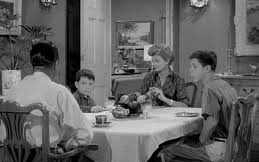
Leave it to Beaver (1957-1963) is an ideal example of the ways in which popular culture was used to advertise suburbia, presenting a family sitcom in which the mother is characterised by domesticity whilst the father is depicted as a professional figure, and the children return home to tell stories of their days at school; this patriarchal set-up would have given viewers of the 1950s a lifestyle to aspire to, particularly in the context of post-war America. Suburbia offered America’s returning servicemen a desirable place to live and start a family, in a secure environment that escaped the crime and diversity of the city. Thus, American suburbia came to represent a new American dream, encapsulated by safety, stability, and a sting sense of community.
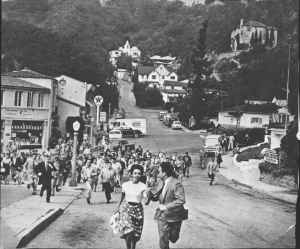
However, following criticisms of suburbia’s exclusivity, particularly in terms of race and class, TV and film representations became suspicious of the suburbs, and began depicting a less-than-perfect portrait of suburbia. This shift in attitude towards the suburbs is reflected in films such as Invaders from Mars (1953) and Invasion of the Body Snatchers (1956), both of which use the genre of science fiction to emphasise the threat that the outside world posed to suburbia’s elite community. The uniformity and tranquility of America’s suburbs provided an ideal setting for disruption, hence the frequent use of invasion terminology in such films’ titles; these suggest a strong notion of insider/outsider values, which highlight the elitism that existed in America’s suburbia.
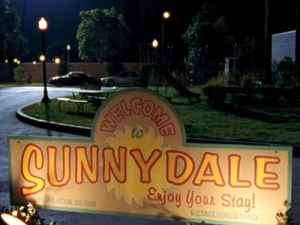
Similar ideas are also explored in the popular TV series, Buffy the Vampire Slayer (1997-2003), in which a young, female suburbanite is trusted with the responsibility of protecting suburban ‘Sunnydale’ from various monsters and demons that flock towards the town’s Hellmouth. The series is particularly interesting as it focuses on the defence of the suburbs, offering a counter-force to the threat of invasion. Additionally, the ignorance of the majority of Sunnydale’s resident is frequently mocked throughout the show, allowing for an interaction with suburban stereotypes alongside the reinforcement of suburban lifestyles, which are worth defending.
Tim Burton’s Edward Scissorhands (1990) deals with the same threat of invasion from an entirely different perspective, representing the sensibility of the outsider in an effort to critique the narrow-mindedness of suburbanites, amidst an array of pastel coloured houses and carefully mown lawns. The unnamed suburban town is constructed through various cliches, such as a aesthetically pleasing homes and the frequently visiting, and often intrusive, neighbours. However, Edward Scissorhands’ gothic castle over-looks the town from a nearby hill, looming in the distance in a threatening manner, continually reminding the town’s residents of the potential threat of the outsider. When Edward crosses the boundaries into the town he is initially received with curiosity and a slightly unwelcome reception, though the townspeople eventually begin to treat him fondly, as a kind of spectacle. Edward’s deviance from the norm is both intriguing and threatening, although the end of the film sees the residents turn against him during a rapid series of unfortunate events. In his construction of this dark fairytale, Burton highlights the elitism of suburbia, which proves to be a hostile environment for the outsider. Thus, the film reverses the notions expressed in earlier science fiction examples, suggesting that suburbia itself is the threat, particularly to those who do not conform to suburban standards.
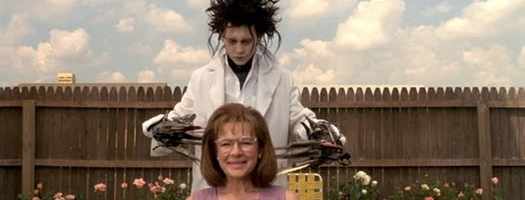
What’s striking about these various representations of the suburbs is that they all perpetuate the same aesthetic, despite their tendencies towards critique or subversion. The stereotypical uniformity of houses, often with picture windows, and always with impeccably maintained gardens, infiltrates almost every representation of suburbia in popular culture; this maintenance of the suburban portrait is especially evident in contemporary representations of suburbia. Recent TV shows such as Desperate Housewives (2004-2012) and Suburgatory (2011) aim to satirise stereotypical conceptions of suburbia, but arguably continue to sell the same idealized notions of suburban life. Wisteria Lane, the notoriously charming setting of Desperate Housewives, offers the viewer a portrait of suburbia consisting of white-picket fences and large, attractive houses. In its efforts to satirise suburbia for its dated ideals and exclusivity, Desperate Housewives ultimately presents the viewer with an idealised vision of life, which mainly conveys wealth, health and happiness, despite a few blips here and there. Similarly, the recently broadcast Suburgatory depicts a young girl’s anguish at being forced to live in a suburban town with her father, amidst an array of stereotypically shallow and gossiping neighbours. However, the aesthetics are again largely appealing, with glossy painted houses and frequent exhibitions of wealth.
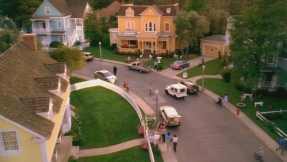
My point, is that these representations not only satirise suburbia, but also aim to keep the notion of suburban living alive. Why is this relevant? Because the idealized suburbs of the 1950s and 60s no longer exist. The inner-ring suburbs, which birthed the all-American way of life, suffered immensely from the effects of economic struggle and the New Urbanist Movement of the 1980s and 90s, as many suburban dwellers flocked back to the cities in search of a more accessible consumerist lifestyle; many of the most popular suburbs have transformed into outer-city slums, as the wealthy middle-classes priced the lower-classes out of the city, forcing them to take residence in the less desirable ex-suburbs. Thus, contemporary representations of suburbia in popular culture that rely heavily on suburban ideals can be perceived as an attempt to hold on to a reality that once existed, but has since been lost. Amongst other examples, Wisteria Lane offers a vision of suburbia that is fondly remembered by most of Desperate Housewives‘ viewers, many of which would have spent their childhood in a suburb. The desperation to keep the suburbs alive, if only through representation, is encapsulated in our tendency towards suburbanophilia, which is rapidly spreading throughout the United States and the UK.
Suburbanophilia can be further understood in relation to Bachelard’s Poetics of Space, which explains that ‘we comfort ourselves by reliving memories of protection.’ Protection, for most Americans, is a concept entwined with the traditional values of suburbia, established following the Second World War, and during the later threats of communism, in which suburbia became a kind of haven from potential disaster. The isolation of many suburbs emphasises a comforting notion of enclosure and security, which many American’s would associate with their childhood; it is therefore unsurprising that during a period of social disruption, nostalgic images of an American ideal would begin to reemerge in popular culture.
In maintaining the same suburban aesthetic throughout half a century of popular culture, we have established a stereotype that reminds us of a simpler way of life, offering a comforting glance into the past. Removed from the social and economic instability of the city, the isolated suburb provides a sense of escapism through nostalgia. As a society, we are charmed by the triviality of suburban life, and we enjoy following the hopeless dramas of fictional lives. Despite having moved on from dated 1950s ideals, we still find it hard to resist the white picket fences and long winding streets of suburbia.
What do you think? Leave a comment.




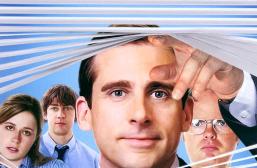

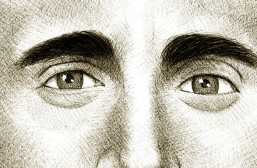


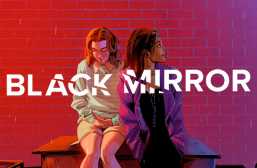

Desperate Housewives was one of those shows that, for me, made me smile in every episode. It had everything in it to make it one of my favorite shows, with it’s charm, comedy, mystery, and drama.
This was the first show that I really became attached too. The characters were relatable in some ways, and I felt as though they were real. It just gave me happiness, and laughs when I needed it the most, and so when the finale started so did my tears. I cried throughout the whole thing, but not really out of sadness but out of happiness. The show truly changed my perspective on things believe it or not, and I thank it for that.
I was pleasantly surprised when i watched suburgatory expecting nothing special. But it is good.
Really good and interesting article. In my hours of research about the American family on TV, I believe one of the shows that really showed the suburban life in early TV (along with Leave it to Beaver, like you’ve mentioned) is The Dick Van Dyke Show. Much like LITB, Dick Van Dyke Show depicted that typical American suburban family. But along with that, what I think it did more so than LITB was the depiction of the suburban neighbors. However, the 50s and 60s were the heyday of American suburbia and I think many shows from that time depicted life as such. I really enjoyed this read.
Thanks for your comment, Robert! And for your recommendation. I haven’t seen The Dick Van Dyke show, but I’ll definitely check it out – suburban neighbours are always depicted with such animation!
Its been 10 bloody years since DH started. Honestly, it feels like it was just yesterday that it started. Sure the show lost its magic after season 1, but I watched it 2 the bitter end.
As a white suburban male, I can say that the media has glorified my lifestyle, although there’s not much ideal about it. I can walk to most places I need to get to, which is nice, but my neighbors are intrusive and the people I know all seem to already know my business. I think there are drawbacks and benefits, and it’s all a matter of personal taste.
Eyes on the prize…
As a part of the “Baby Boomer” generation, I too look with nostalgia at the post-war era. But hindsight is not always “rose-colored”…
The American Dream through the Post War suburban lens perpetuates within a limited demographic, leaving behind everyone that doesn’t fit that paradigm. The reminiscence of this golden era creates a visual standard, unrealistically presented, and overly idealized. While carefully maintaining the status quo, this post-war, consumer-driven culture reinforced the notions of acceptable standards, political correctness, and stifling conformity. Through this view, reactionary movements, liberation movements and civil rights were too controversial to be included. Could this suburban phenomenon have delayed the otherwise overdue changes within the American mindset?
The millennial(s), Gen X, Gen Y, have the advantage of self-defining. Fortunately, the confines of the suburbs are not infused within their concept of self. Your article was insightful, and I enjoyed your examination of the suburban experience through film and television media-
I’ve always been fascinated with suburbia, so this article caught my eye immediately. I was a bit surprised to see it missing the movie Pleasantville. Maybe it’s a bit corny now, but I remember it was mind-blowing to me at the age of 12. In the movie, color is brought the suburban world with acts of corruption – while an obvious metaphor, it was visually an effective one, and thought-provoking. I highly recommend the Mike Mill’s short film, the Architecture of Reassurance, which is basically a testament to the Poetics of Space quotation.
Interesting read. Well written. However, it would be nice if you could delve into the issue of race with regards to this issue. Great job!
Your article does a nice job talking about representations of the suburbs, but I think you could have also given a fuller analysis of the context within which the suburbs of the mid-twentieth century were created. You touch on issues of race and class but I think the concept of white flight should be addressed more deeply. The choice to move to suburbia was not always solely a personally motivated one as there was a broad network of institutional forces encouraging white flight, namely the development of the interstate highway system, racially motivated redlining and mortgage discrimination, blockbusting, and what have you. That small critique aside, I think the examples you chose are awesome, particularly the invasion films of the fifties. You capture the idea of “the other” quite well, noting the reality of the ‘us’ vs. ‘them’ that existed in the era.
This is an intriguing topic for sure, but in my experience the suburban aesthetic and its notions of lifestyle is still alive and well. Media may be perpetuating the aesthetic, but it is not necessarily a remnant of the past quite yet. We may or may not have moved on from 50s ideals, but part of the reason we cannot resist portrayals of “white picket fences and long winding streets of suburbia” is because they still reflect real living spaces in some of our lives.
Also, just as an observation — much of your analysis, which by the way I found rewarding to read, is focused on the exteriors of the suburbia (white picket fences, manicured lawns, pastel colored houses, etc.), when that is not all there is to media that treats suburbia. My personal favorite representations of suburbia are the 50s American melodramas of directors like Douglas Sirk and Nicholas Ray, which actually focus intently on the interior of suburban homes to make their points. I think that they would provide an interesting wrinkle in this discussion of suburbanophilia.
Cool
I couldn’t agree more, David! Our family, with one son, moved to such a place after living happily in a Massachusetts college town, where things were “suburban” but much more laid back. It was a shock to be asked which church we belonged to (none!) and to find that the neighbors actually spied on us with binoculars. I couldn’t get out of there fast enough and am back in the college town, where luckily, nobody asks about our religion or politics or what we’re cooking for dinner; they accept who we are. That’s not an easy thing to find in the U.S.
I think she’s misinformed about suburbia. Suburbs are still the ideal places for most people to live. Inner ring suburbs are the ghettoburbs right now. Mcmansionvilles 30 miles from downtown are certainly NOT the ghetto or undesirable places to live. The little Ranchettes of 1955 that are like 10 miles from downtown are now the ghetto houses of today. The ghettos of the 1990s and 2000s which are 1920s suburbs are now desirable again as they are close to the city and have “old world charm”. In the 70s and 80s downtowns we’re the ghettos. In the coming decades I expect the 50s houses to be popular again and the 1970s homes to become the ghettos of the 2030s. Then likely the ghetto expansion outwards will have to stop as the mcmansions of the 1980s and 90s are too nice and too expensive for poor people to purchase/ rent. Likely the 1970s homes will become desirable again as they are closer to downtown and the inner city will rot out once again bringing the ghetto to downtown like it’s 1974